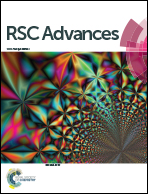Anti-allergic prenylated hydroquinones and alkaloids from the fruiting body of Ganoderma calidophilum†
Abstract
Six new prenylated hydroquinones named ganocalidin A–F (1–6) and two new compounds of ganocalicine A (7) and B (8), together with sixteen known compounds (9–24) were isolated from an EtOAc extract of the fruiting body of Ganoderma calidophilum. The new compound structures were elucidated on the basis of spectroscopic data analysis including 1D, 2D NMR and MS. Compounds 1 and 7 showed inhibitory activity effects on β-hexosaminidase activity (IC50 9.44 and 9.14 μM, respectively), and significantly reduced the production of IL-4 and LTB4 by RBL-2H3 cells in response to antigen stimulation, suggesting that 1 and 7 possess anti-allergic activity.


 Please wait while we load your content...
Please wait while we load your content...